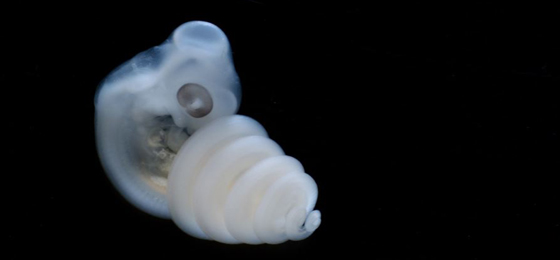The relationship between genitals and hind legs

Schlangenembryo
When vertebrates left the seas and conquered the land, they not only adapted their limbs to the new environment, but also their reproductive organs. Whereas fish and amphibians reproduce under water, reptiles, birds and mammals do so on land. In order to prevent their eggs from drying up, they let their germ cells fuse together inside the body. For this purpose, they had to develop new features.
“Like branches from a tree trunk”
“External genitals make internal fertilisation possible,” says Patrick Tschopp. In the journal “Nature”, the Swiss biologist has traced the origins of the male sexual organ in snakes, lizards, chickens and mice together with his colleagues from Switzerland, France and the United States (*).
In very simplified terms, an embryo at first resembles a tube. As it continues to develop, the upper and lower limb buds begin to sprout. “Like branches from a tree trunk,” says Tschopp. In mice, the hind-leg buds are always separate from the embryonic structures out of which the reproductive organ develops. In snakes and lizards, however, the genitals develop in a way very similar to the hind legs.
Hemipenises
Sex-specific genes are only activated at a later stage, as the researchers have been able to show through elaborate experiments. Hemipenises, the lateral pair of reproductive organs in snakes and lizards, thus probably developed from hind legs (although snakes lost theirs in the course of evolution).
Tschopp specialises in basic research, no treatment methods can be derived from his findings yet. But Tschopp thinks that the results might at least partially explain why, in the case of certain congenital diseases, deformed arms and legs are often coupled with damage to the external genitals. The reason lies in the similar development processes and molecular affinity between sexual organs and hind legs.
(*) Patrick Tschopp, Emma Sherratt, Thomas J. Sanger, Anna C. Groner, Ariel C. Aspiras, Jimmy K. Hu, Olivier Pourquié, Jérôme Gros, and Clifford J. Tabin (2014). A relative shift in cloacal location repositions external genitalia in amniote evolution. Nature online. doi: 10.1038/nature13819 (available to journalists as a PDF from com@snf.ch)
Contact
Dr Patrick Tschopp
Department of Genetics
Harvard Medical School
Boston, USA
Tel.: +1 (617) 432 65 32
E-mail: tschopp@genetics.med.harvard.edu
Weitere Informationen:
Media Contact
All latest news from the category: Health and Medicine
This subject area encompasses research and studies in the field of human medicine.
Among the wide-ranging list of topics covered here are anesthesiology, anatomy, surgery, human genetics, hygiene and environmental medicine, internal medicine, neurology, pharmacology, physiology, urology and dental medicine.
Newest articles

High-energy-density aqueous battery based on halogen multi-electron transfer
Traditional non-aqueous lithium-ion batteries have a high energy density, but their safety is compromised due to the flammable organic electrolytes they utilize. Aqueous batteries use water as the solvent for…

First-ever combined heart pump and pig kidney transplant
…gives new hope to patient with terminal illness. Surgeons at NYU Langone Health performed the first-ever combined mechanical heart pump and gene-edited pig kidney transplant surgery in a 54-year-old woman…

Biophysics: Testing how well biomarkers work
LMU researchers have developed a method to determine how reliably target proteins can be labeled using super-resolution fluorescence microscopy. Modern microscopy techniques make it possible to examine the inner workings…





















